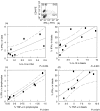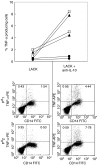Antigen specific correlations of cellular immune responses in human leishmaniasis suggests mechanisms for immunoregulation
- PMID: 15086400
- PMCID: PMC1809031
- DOI: 10.1111/j.1365-2249.2004.02426.x
Antigen specific correlations of cellular immune responses in human leishmaniasis suggests mechanisms for immunoregulation
Abstract
Regulation of the immune response directed against Leishmania is critical for the establishment of effective control of the disease. It is likely that some types of immune responses directed against Leishmania can lead to more severe clinical forms of leishmaniasis causing a poor control of the pathogen and/or pathology, while others lead to resolution of the infection with little pathology as in cutaneous leishmaniasis. To gain a better understanding of the possible role that subpopulations of T cells, and their associated cytokines have on disease progression and/or protective immune responses to L. braziliensis infection, a detailed study of the frequency of activated and memory T cells, as well as antigen specific, cytokine producing T cells was carried out. Following the determination of cytokine producing mononuclear cell populations in response to total Leishmania antigen (SLA), and to the recombinant antigen LACK, correlation analysis were performed between specific cytokine producing populations to identify models for cellular mechanisms of immunoregulation in human cutaneous leishmaniasis. These studies have shown: (1) a positive correlation between ex vivo CD45RO frequencies and antigen specific cytokine (IFN-gamma or IL-10) producing cells; (2) a negative correlation between ex vivo CD69 expression and the frequency of IFN-gamma producing cells; (3) a positive correlation amongst SLA specific, IFN-gamma or TNF-alpha and IL-10 producing lymphocytes with one another; and (4) a higher frequency of IL-10 producing, parasite specific (anti-SLA or anti-LACK), lymphocytes are correlated with a lower frequency of TNF-alpha producing monocytes, demonstrating an antigen specific delivery of IL-10 inducing negative regulation of monocyte activity.
Figures





References
-
- Barral A, Pedral-Sampaio D, Grimaldi JG, et al. Leishmaniasis in Bahia, Brazil: evidence that Leishmania amazonensis produces a wide spectrum of clinical disease. Am J Trop Med Hyg. 1991;44:536–46. - PubMed
-
- Mocci S, Coffman RL. Induction of a Th2 population from a polarized Leishmania-specific Th1 population by in vitro culture with IL-4. J Immunol. 1995;154:3779–87. - PubMed
-
- Sacks DL, Noben-Trauth N. The immunology of susceptibility and resistance to Leishmania major in mice. Nat Rev Immunol. 2002;2:845–58. - PubMed
-
- Liew FY, Xu D, Chan WL. Immune effector mechanism in parasitic infections. Immunol Lett. 1999;65:101–4. - PubMed
Publication types
MeSH terms
Substances
LinkOut - more resources
Full Text Sources
Medical

